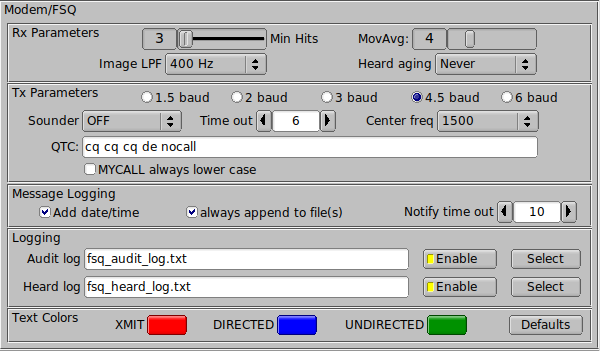Table of Contents

Rx Parameters
The FSQ decoder is essential a set of single frequency filters spaced by the interval samplerate / symbol_length, 2.93 Hz. The filters are achieved using a Fast Fourier Transform. Each spectral line (or bin) of the FFT is then filtered using a time domain filter called a moving average (boxcar) filter. The moving average filter is the optimum filter for locating a signal transition in the time domain. The moving average filter can be adjusted to average 1 to 4 samples. A setting of 1 disables the filter. The default value for the moving average filter is 3.
The filtered spectral lines are then tested for maximum value. The Min Hits adjustment sets the number of consecutive times a spectral line is the maximum before being designated as a detected signal. Min Hits can be set over the range 3 to 6. The default value is 3.
Images are detected by first converting the signal to a base band. This is accomplished by mixing a 1500 Hz sine wave with the rx stream. This is equivalent to an analog receiver that using direct conversion. The down converted signal can be filtered to reduce the effect of noise. Your choice is NONE, 300, 400 or 500 Hz for the low pass filter 6 dB cutoff frequency. Use the narrower filters for noisy conditions, but remember that filtering will both reduce the image noise and also blur the image.
Callsigns that satisfy the parsing requirements will be added to the FSQ heard list. You can elect to have the heard list periodically managed so that older entries are removed or aged. The user can elect no aging, Never; or 1, 5, 10, 20, 30, 60, 90, and 120 minutes.
Tx Parameters
FSQ transmissions can occur ar 2, 3, 4.5, or 6 baud. The default rate is 4.5. The baud rate can be selected on the fsq configuration tab, or by left clicking on the left most entry on the fldigi main dialog status bar.
FSQ "Sounding" is a periodic transmission of your call sign followed by a colon. The Sounding signal is a way of announcing your presence on the channel with the smallest possible data stream. Other FSQ stations will add you to their Heard list if they detect your Sounding signal. You set the Sounding interval to OFF, 1, 10 or 30 minutes.
Your QTC text can be sent using the "QTC" button on the main dialog. It can also be requested for auto reply by another FSQ station.
All FSQ transmissions are designed to be inhibited so long as the software detects a received signal (open squelch).
Logging
Any of the text in the Rx Panel or the Monitor Panel can be captured for copy, and saving to a file. Simply right click on the panel for a pop menu.
Fldigi's FSQ also saves a continuous log of all Heard stations, and an Audit log that includes all received data. These logs are named fsq_heard_log.txt and fsq_audit_log.txt respectively. The logs are never cleared unless the operator does so using the operating system file handling facilities. Data is appended to each log as it occurs. These logs are located in the fldigi temp folder:
XP | C:\Documents and Settings\<username>\fldigi.files\temp |
Vista | C:\Users\<username>\fldigi.files\temp |
Win7 | C:\Users\<username>\fldigi.files\temp |
Win8 | C:\Users\<username>\fldigi.files\temp |
Linux | /home/<user>/.fldigi/temp |
OS X | /home/<user>/.fldigi/temp |
Unix | /home/<user>/.fldigi/temp |
You can elect to disable the logging functions. You may also rename the log to suit your particular operations.